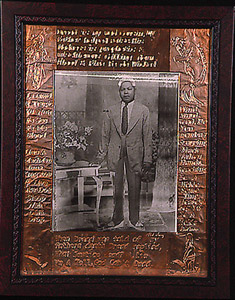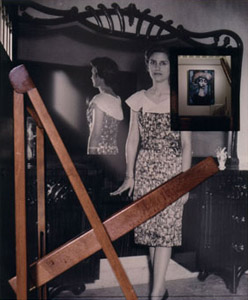“Emphasis” by Juan Antonio Molina |
chapter I | chapter II | chapter III | chapter IV | chapter V
IV
All of these variables are self –referential. Not only regarding the fact that photography seeks attention for itself, but also because the author seeks attention for his identity, either by showing it or concealing it, but always representing it. The photos that have driven me to make this analysis are the result of a journey from the interest for the collective configuration of identities towards the interest for the conformation-dissolution of individual identities.
Even in the mentioned examples, which in a more or less parabolic manner deal with the collective determination of meaning, we can find self-affirmation procedures, which leads us to think that individualism is one of the strongest ideological trends of contemporary photography. This is remarkable but only in a context such as the Latin American, where individualism implies a criticism and a resistance to accept the representation/identity/militancy coordinates of the guild.
Self-referentiality is unavoidable in a practice that seeks the intangible and the untraceable. Let us remember that many of these pictures are more about subjectivity than about a subject. But it is in that diffuse subjectivity where we get closer to the author’s self. But while the subject remains latent in some corner of the weft of meanings of the work, subjectivity is expanded as an aura surrounding the aesthetic object, supporting it and building it. It is the self as subjectivity, and not the subject as a figure, which in the end is revealed in each one of these images. Fantasy, dream or revelation are expressions of such subjectivity, and also memory, so insistently evoked in the works of Eduardo Muñoz, Graciela Fuentes, or Albert Chong. All of these authors seem to be marked by a particular experience of transit, migration or displacement. In consequence, memory becomes a resource for anchoring, seeking and rescuing the origin or just a testimony of a passing. Photography recovers its primal commemorative function and dramatically exhibits its documentary quality.
More than nostalgia, there seems to be a critical revision of the past. There is a sort of tension between the present and the past, which is heightened by the ideological construction of the photo by opposites: biography and history, private and public, individual and collective. In a visual level, these opposites meet in a texture of montages. All of it has an effect of abstraction, made by a superimposition of plains and moments.
It is also an effect of inter-textuality, which helps photography to show itself as a self-reproductive object. For them, the personal history is a history marked by visual experience, especially in the work of Chong and Muñoz, the location and relocation of documents implies a reiteration of the acts of looking and reading. This is achieved by amplifying the reproductive possibilities of the photographic image.
 |
 |
1995 © Albert Chong |
"Untitled" from the series Sabina's letter. 1999 - 2001 © Eduardo Muñoz |
In Muñoz’s case, quotes can vary from individual to more “cultivated” sources that explore the history of contemporary photography or cinema. Albert Chong uses more melodramatic referents, such as a kitsch element that is relocated in the structure of his work. Along with the recuperation of biographical evidence and reconstruction of the affective universe, the ornamental is also infiltrated, with the purpose to reconstruct a very personal aesthetic experience. Apart from the meaning of this eclecticism in terms of the relationship of several cultural referents, I also see it as part of a quasi-therapeutic condition characteristic of this kind of autobiographical work.
These photos show a dynamic surface, with a strong expression and powerful capacity for visual, psychological and emotional impact. The work of Graciela Fuentes is an eloquent example of that coincidence between the body photographic and the photographed body, which is based in the representation of images projected on a human body. In these pictures, the skin looks like both a surface and atmosphere. That is the evidence of subjectivity, but also its context giving the body human a territorial quality in which the signs of placement and displacement. Tatiana Parcero makes a similar attempt by superimposing maps over the body or parts of it. Although her results have a much more cartographic character, and the superimposition of plains does not have an effect of tri-dimensionality and atmosphere like the work of Graciela Fuentes.
We live in a time of pragmatism where art is forced to adopt strategies to find its place, ways to be disseminated and realization as an artistic object. Art seems to be understood as strategic, as mainly discursive, even as propaganda. The utilitarian and effectist vision is dominating, in the sense that an effect or result is sought and can be traced to the very origin of the production of the artistic object. Because of this, contemporary art rejects leisure. The work of art is expected to drive to an experience outside of the artistic object. Political, sociological or economical, it is outside of the traditional spaces assigned to the artistic experience.
In such a context, production, reproduction and spiritual expression are seen as exchangeable values, but also as being too abstract for the political and pragmatic purposes of the discourse of contemporary art. In fact, spirituality is something to be intuited instead of perceived. Something that is beyond the physical construction, even when language makes an effort to construct it and configure it.
Another not less profitable possibility for the new ideological order that prevails in contemporary art, is that a kind of photography like the one I have commented about here, has only recognition as a folkloric asset. That it will be consumed thanks to its marks of a real or imagined collective identity, an evaluated for belonging to an exotic geographic, cultural and artistic environment.
Facing such risks without concealing the existence of local specificities and features might be a challenge, not for photographers but for art critics and that other strategic manifestation that is curatorial work. The result could even help to understand the coherence of these photographic practices and the more critical and propositional zones of the current art. In that sense, an optimistic vision is valid. A vision that in these aesthetic productions, looks for a critical spirituality instead of spirituality in crisis
Juan
Antonio Molina
juanmolinac@prodigy.net.mx